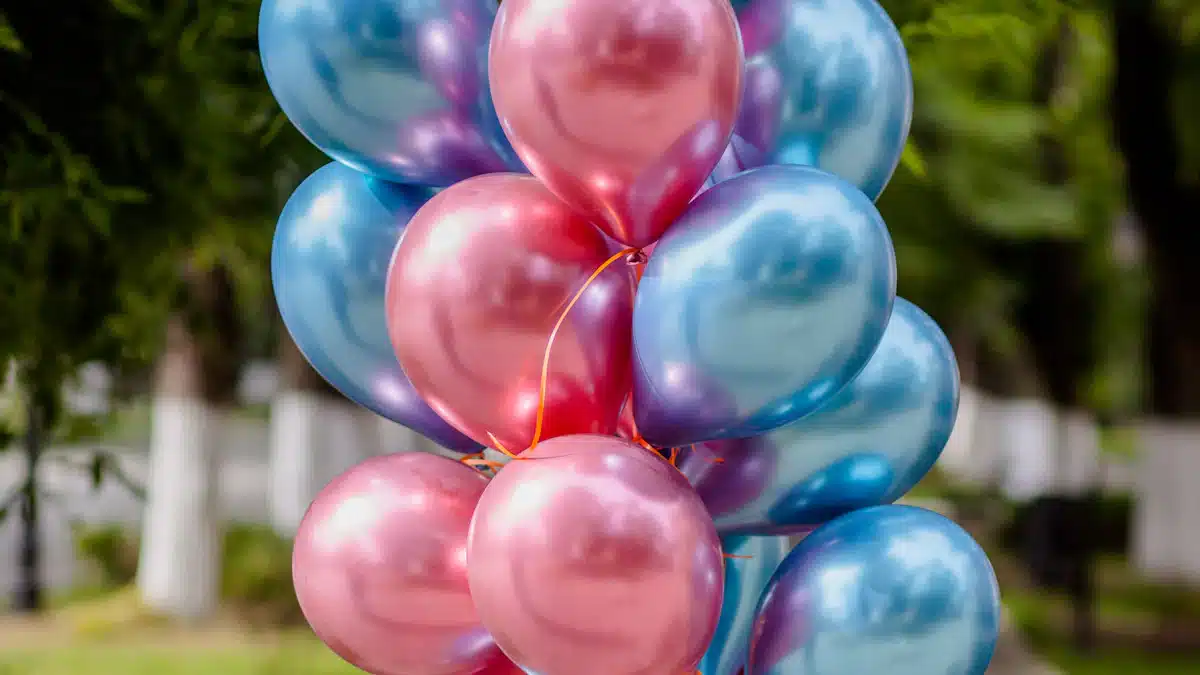
Did you know latex balloons filled with helium can float for hours but often deflate sooner than expected? Their average lifespan ranges from 8 to 12 hours, depending on factors like size and material. Helium naturally escapes through tiny pores in latex balloons, but with the right care, you can keep your latex balloons afloat much longer.
Key Takeaways
Choose high-quality latex balloons to reduce helium leaks and extend float time.
Use Hi-Float to coat the inside of balloons, allowing them to float for days instead of hours.
Inflate balloons close to your event time to ensure they look fresh and vibrant.
Factors That Affect the Average Lifespan of Latex Helium Balloons

Several factors influence how long your latex helium balloons stay afloat. Understanding these can help you make better choices and extend their float time.
Balloon Size and Material
The size of your balloon plays a big role in its float time. Larger balloons hold more helium, so they naturally float longer. For example, a 15-inch balloon will outlast a smaller 5-inch one. If you want your balloons to last through an event, opt for bigger sizes.
The material also matters. Latex balloons are made from natural rubber latex, which is more porous than foil. This means helium escapes faster, shortening their lifespan. However, high-quality latex balloons are thicker and have a tighter molecular structure. They slow down helium leakage and stay inflated longer. Cheaper, thinner balloons might save you money upfront, but they deflate quickly and could ruin your event.
Environmental Conditions (Temperature, Humidity, and Wind)
Environmental factors can make or break your balloons. Temperature changes, for instance, cause helium to expand or contract. In hot weather, helium expands and might pop your balloons if they’re overinflated. On the other hand, cooler temperatures make helium contract, making the balloons look deflated. Cooler conditions are better for longer float times.
Humidity also affects latex balloons. High humidity increases the material’s porosity, causing helium to escape faster. It can even weaken the latex, leading to quicker deflation. To avoid this, keep your balloons in a shaded, dry area. Wind can also damage balloons by causing them to rub against surfaces, which weakens the latex.
Quality of Helium and Inflation Technique
The quality of helium you use matters more than you might think. High-purity helium contains fewer impurities, which reduces leakage and extends float time. Low-quality helium, on the other hand, can cause your balloons to deflate faster.
Inflation technique is equally important. Stretching the balloon before inflating it helps it hold more helium. Proper inflation to a teardrop shape also prevents overinflation, which can lead to faster helium escape. Always inflate your balloons carefully to maximize their lifespan.
How to Extend the Float Time of Helium-Filled Balloons
Use Hi-Float or Similar Products
If you want your helium-filled balloons to last longer, using Hi-Float is a game-changer. Hi-Float is a gel-like solution that coats the inside of latex balloons before inflation. This coating creates a barrier that slows down helium loss, allowing your balloons to float for days instead of hours. For untreated latex balloons, the float time is typically 8-15 hours. However, with Hi-Float, they can last up to 25 times longer!
Applying Hi-Float is simple. Just pump a small amount into the balloon, spread it evenly, and then inflate it with helium. This product works best with helium-filled latex balloons and is perfect for events where you need decorations to stay vibrant and buoyant for extended periods.
Opt for Larger Latex Balloons
When choosing balloons, size matters. Larger latex balloons hold more helium, which means they float longer. For example, a 15-inch balloon will outlast a smaller 5-inch one. If you’re planning a long event, bigger balloons save you from constant replacements. Here’s a quick guide to how long helium balloons last based on size:
Latex Balloon Size | Average Flying Time (Helium Only) | Average Flying Time (Helium and ULTRA HI-FLOAT) |
|---|---|---|
11 inches | 12-24 hours | 1-4 weeks |
16 inches | 30+ hours | 3-7 weeks |
24 inches | 2-4 days | 4-10 weeks |
Store Balloons in Cool, Stable Conditions
Temperature and humidity can affect how long helium balloons last. To maximize float time, store them in a cool, dry place. Avoid direct sunlight, as heat can cause helium to expand and escape faster. Similarly, cold temperatures make helium contract, shrinking the balloons and increasing helium loss. Stable indoor conditions are ideal for keeping your balloons afloat longer.
Inflate Balloons Close to the Event Time
Timing is everything when it comes to inflating helium balloons. While you can inflate them the night before, they may lose some buoyancy by the time your event starts. For the best results, inflate your balloons just a few hours before the event. This ensures they look fresh, vibrant, and ready to impress your guests.
Common Mistakes That Shorten the Float Time of Latex Balloons
Even with the best intentions, small mistakes can drastically reduce the life expectancy of latex balloons. Let’s explore some common errors and how to avoid them.
Overinflating or Underinflating Balloons
Getting the inflation just right is crucial. Overinflating balloons puts too much stress on the latex, making it more porous and causing helium to escape faster. On the flip side, underinflating balloons means there’s not enough helium to keep them afloat for long. Both scenarios can lead to disappointment when your helium-filled latex balloons don’t last as expected.
To avoid these issues, inflate your balloons to a teardrop shape rather than a pear shape. This ensures the latex isn’t overstretched. If you’re using helium balloons for an event, practice inflating a few beforehand to get the technique right.
Exposing Balloons to Heat or Direct Sunlight
Heat is one of the biggest enemies of helium-filled balloons. When exposed to high temperatures, helium expands, which can cause balloons to pop unexpectedly. Direct sunlight also weakens the latex material, making it more porous and prone to leaks. In humid conditions, the problem worsens as moisture further degrades the latex.
To protect your balloons, keep them in shaded areas and avoid leaving them in hot environments like cars or outdoor spaces during peak sunlight hours. If you’re hosting an outdoor event, consider using fans or misting balloons lightly to keep them cool. These simple steps can help your balloons float longer than 15 hours.
Using Low-Quality Balloons or Helium
The quality of your materials matters more than you might think. Low-quality balloons are often thinner and made from inferior materials, which leads to faster helium leakage. Similarly, low-purity helium contains impurities that can reduce float time. If you’ve ever wondered, “How long does a helium balloon last?” the answer often depends on the quality of both the balloon and the helium.
Invest in high-quality helium balloons designed for durability. Look for professional-grade latex balloons or helium-grade options to ensure they perform well. While they may cost a bit more, they’ll save you the frustration of balloons deflating too soon.
By avoiding these common mistakes, you can maximize the float time of your helium-filled balloons and keep your decorations looking festive for hours—or even days!
Extending the float time of helium-filled latex balloons is easier than you think. By focusing on a few key steps, you can keep your balloons festive and afloat for much longer.
Choose high-quality latex balloons to reduce helium leaks.
Use Hi-Float to create a barrier inside the balloon and slow helium loss.
Inflate balloons close to your event for maximum buoyancy.
Store them in cool, dry conditions away from sunlight and heat.
Avoid common mistakes like overinflating or exposing balloons to extreme weather. With these tips, your decorations will stay vibrant and ready to impress your guests! 🎈
FAQ
How long do balloons last when filled with helium?
Latex helium balloons typically float for 8-12 hours. With Hi-Float, they can last several days. Larger balloons and proper care extend their lifespan even further.
Can I reuse latex helium balloons?
No, latex balloons are single-use. Once deflated, the material weakens and cannot hold helium effectively. Consider foil balloons if you need reusable options.
What’s the best way to transport helium balloons?
Use a large, enclosed vehicle. Avoid sharp objects and extreme temperatures. Secure the balloons to prevent them from shifting or popping during transit.






3 thoughts on “How to Extend the Float Time of Latex Helium Balloons”
Pingback: Foil Balloons Vs Latex Balloons For 30th Celebrations
Pingback: Eco-Friendly Helium Tanks For Balloons You Should Try
Pingback: How Long Will Your Helium Latex Balloons Stay Inflated? – Chaoee